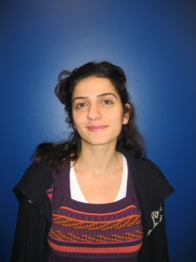Controlled Polymer Nanostructures by Alternative Lithography
Promotion date: 12. February 2010
Promotors: Prof. Dr. Jurriaan Huskens and Prof. Dr. Julius Vancso
Assistant Promotor: Dr. Mark Hempenius
| The role of organometallic polymers was studied, in bottom-up and top-down nanofabrication techniques to provide patterned platforms. Poly-ferrocenylsilanes (PFSs) were explored for their use in top-down fabrication, since they show a high etch resistance to reactive ion etching (RIE). Different lithography techniques were employed to fabricate patterns of PFS, on the micro- and nanoscale. Furthermore, phase separation in block copolymers was used to create bottom-up patterns on a nanometer scale. Surface-initiated polymerization was performed for the preparation of polymer brush patterns for use in biological applications. |
During the thesis project you were using a lot of different fabrication techniques. Was this the initial goal?
Yes, it was a clear project from the start and it suited my way of working very well. Using iron and silane based polymers in lithographic techniques is attractive, because the surfaces are resistant to etching.
A vast majority of the time, I spent in the cleanroom working on different projects at the same time. You could say I betted on more horses. Of course, I met several problems, but also several solutions to them.
Which part did you like especially?
The membrane application we built, was special. The combination of nanospere lithography and a mask transfer technique, allows the fabrication of uniform, nanoporous poly-ethersulfone membranes. Also RIE was used to fill the pores. The membrane was removed from the substrate by dissolving it in acetone.
The PES membranes exhibit highly ordered pores to serve as a platform for size-selective filtration of particles. A real application emerged for filtration between 60 – 300 nanometer. The approach was quite new and was published successfully in Advanced Materials.
Also the brush patterns in biological applications I liked very much, because of the combination of techniques used there.
What are your future plans?
First of all I like to stay in academic research, learning still more techniques. I like experimental work most because one can see directly what is done. I like holding the polymers in my own hands. Here in Europe, and certainly at Mesa+, the facilities are very good. The cooperation with the cleanroom staff and members from other groups was very fruitful. All these nanofabrication techniques I learned during this thesis project. That’s a good thing, in my opinion, because that is one of the main purposes of the PhD work.
What, in your opinion, is important for Mesa+ in the future?
I am really enthusiastic about my work here at Mesa+. It provided me a lot of opportunities to develop myself as a researcher and scientist: the lab-facilities, the help from colleagues and the possibilities to go and visit conferences all over the world.
Perhaps a suggestion is to organize career days for the thesis students. There are possibilities to search for future opportunities yourself or get into contact with interesting people by own initiatives. I guess Mesa+ can provide some service from their part, to meet interesting people from the industry, by using their contacts and working relationships. For example, a meeting day can be organized where companies can present themselves by giving specialized talks and by a market or poster exhibition.

